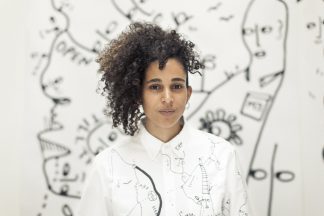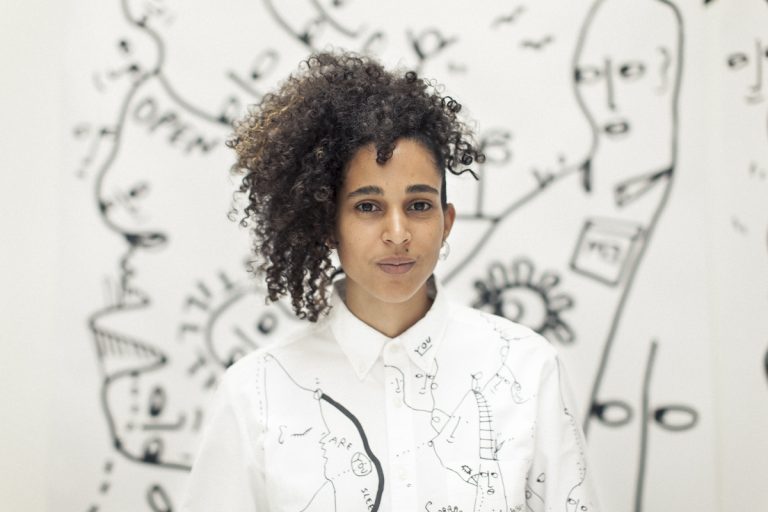The British-born artist has collaborated with Kendrick, Adidas and the Whitney—and is currently working on her choreographic debut

Photo by Catalina Kulczar
The pen may be mightier than the sword, but is the drawing more powerful than the word? It might be if you’re Shantell Martin. The British-born artist specializes in line drawing and currently has a hard-to-miss mural up at the pizzeria Saraghina in Bed-Stuy, an exhibit and capsule collection at the Whitney Museum, has done collabs with Adidas and Puma, and an AI project with Google.
Based in New York since 2008, Martin made a name for herself by drawing live along to live music sets for performers including Kendrick Lamar, creating art in real-time in front of an audience. Her characters, faces, creatures and messages spring from a stream-of-consciousness style, all drawn on an array of surfaces from paper to wall to screen to canvas.
Next up: Martin is working on her choreographic debut with the Boston Ballet for their ChoreograpHER program, which has been delayed due to Covid.
Brooklyn Magazine sat down with Shantell Martin to talk about her background, her art, and feeling like a perpetual outsider in spite of her increasingly inside status.
You were born in England, lived in Japan, then came to the United States. How did that inform your creative approach?
The first thing that comes to my mind about my upbringing is not fitting in. I never felt like I fit into my family, my school, or community. I was the kid who didn’t hang out with no one but with everyone. I was always an outsider, but in a good way. I think that’s reflected in my career as an artist. I’m in these worlds or spaces as always on the outside but as an insider.
An outsider how?
Physically I have a different father to my brothers and sisters. They are all white and blue eyes. I grew up in southeast London in a very white working-class area and I am brown with an Afro. As I walked out of my house as a child I’d get: “Why are you here? Why are your sisters like that?” As a young person, you want to feel included. Looking back though, that was like my first passport to be different. We are primarily on this journey of self-exploration. To do that, you have to be confident and comfortable in yourself.
Why line drawing, then?
The biggest accelerator to my drawing started in Japan. When I went to art school my work was predominantly line work. In 2003, I moved to Tokyo where I started a career as a VJ [visual jockey]. I did visuals to DJs, dancers, and musicians. Essentially, I would be doing this for hours, analog or digitally. My drawings would be projected on the screens. Subconsciously, I’m extracting [from the music as it’s playing] and drawing. What I came to find when you don’t have time to think, plan, or research but you see yourself on the canvas. The lines you are making and words you are writing are coming from somewhere within you. That becomes the foundation or root of your style of your identity. It was always there before, but it was fast tracked in through this process of line drawing and stream of consciousness.
So it’s drawing as performance? When do you feel most creative?
I don’t call myself a performer, but on some level, I want that connection with other people. I’m most creative when people are watching me: On a stage, at an event, or performance or some constructive scenario when I am doing my thing live. I’m most inspired, creative, and most active when the creativity is activated by other people. I’m not saying I don’t draw by myself, but I feel most driven to draw when it’s a shared experience.
You currently have a mural up at Saraghina in Bed-Stuy. How did you choose that spot?
Long story short, my murals are commissioned by a city or an institution. I used to eat breakfast at Saraghina restaurant. I have a mural in Columbia School of Journalism in the Pulitzer Hall. I have a mural in Three Columbus Circle.
How did your collaborations with Adidas and Puma come about?
By an email in my inbox. Someone reaches out and says, “We are a big fan of yours and we’d like to work with you.” It’s about going through the check-list to see if you’d like to work with them. Puma was a much larger scale project. I did apparel, accessories, and it was global. Adidas was a more low-key project. It was local to New York. Sometimes you’ll see that with my projects. Sometimes they’re global and other times intimate.
It’s such a different platform for you.
I am a strong believer in product as well. I have the first ever artist product collaboration with the Whitney Museum right now. I’m a big advocate in art as sneakers, postcards, or art as something else because those are tangible items that the everyday person can own, collect, and gift. It doesn’t come with the intimidation of the art world either. You can put a message on a t-shirt or a pair of sneakers with integrity, a high standard, and high quality. The value is there, but on many different levels.
Kendrick Lamar is a fan of your work. You created art while he performed at Art Basel in 2016. How did the collaboration come about?
To be honest, I never listened to his music. Then I spoke to his team, they told me about his story and narrative and where he is coming from and they said they wanted to work with me. Essentially, it was a great collaboration from two unique creative people who had a solution to their craft, music and drawing. It opened up my world to creativity and music.
What would you be doing if you weren’t an artist?
I’d probably be a manager for creative people. I’d probably be building agencies and new technologies still in the creative field. I feel like it’s more rewarding in the creative field.
Does the fact that it’s Women’s History Month mean anything to you?
It’s about creating the places for ourselves in the future, where we could learn from the lessons from the past and build a positive, fresh way in the future. It would be nice if there were no Women’s History Month, if women were respected in the world.





